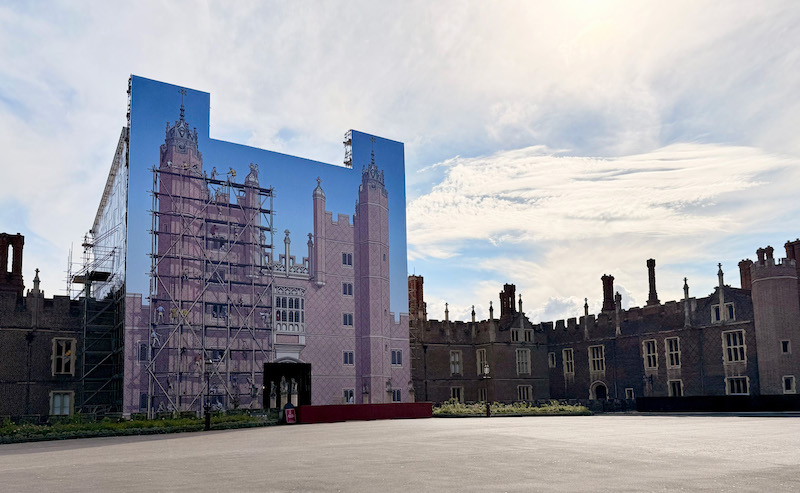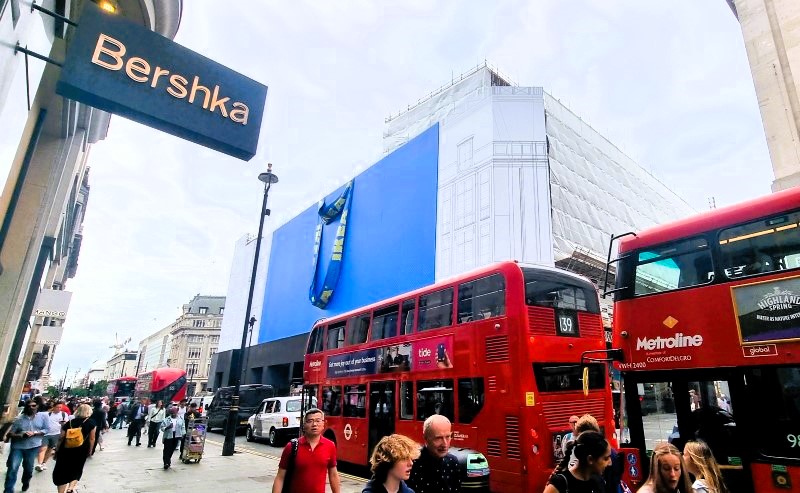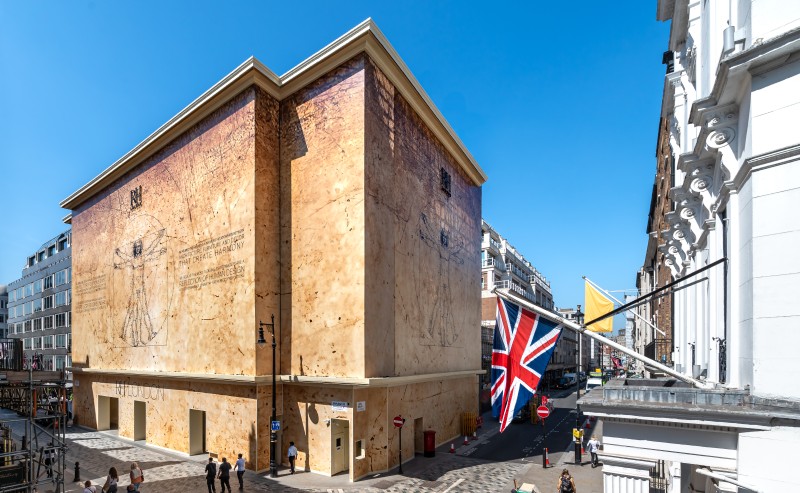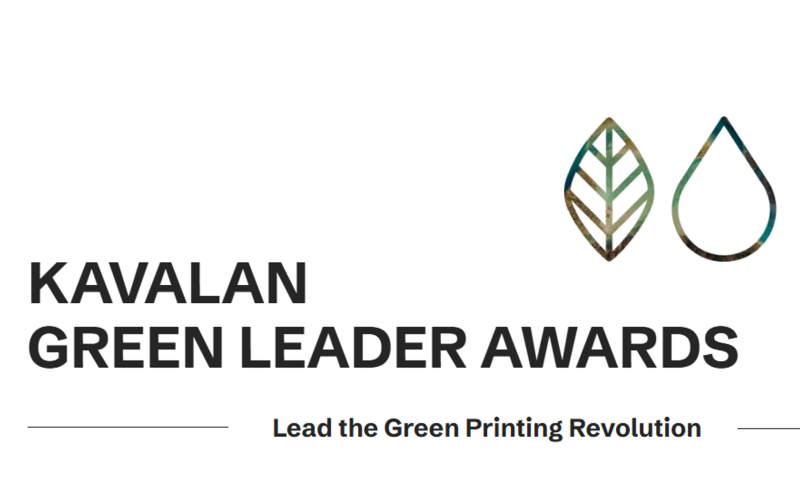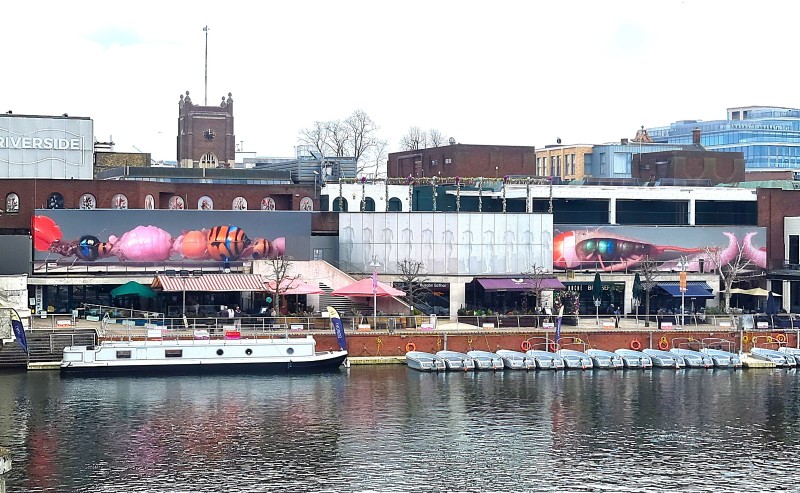From dust to drama: turn construction sites into show‑stopping billboards
Key points – at a glance
- Building wraps are giant printed banners or vinyl graphics that cover scaffolding and facades during construction. They hide unsightly works and deliver round‑the‑clock advertising.
- Wraps turn building sites into high‑impact marketing platforms, reaching drivers, pedestrians and local residents with eye‑level brand messaging.
- They enhance public perception by beautifying worksites, telling stories and preserving heritage facades. Wraps can replicate architectural details, create trompe‑l'oeil art or promote upcoming developments.
- High‑quality materials such as PVC‑free mesh and vinyl are durable, breathable and safe. Sustainable options and recycling schemes minimise environmental impact.
- Successful wraps require expert engineering, planning consent and collaboration with local authorities. Choosing an experienced provider ensures safety, compliance and creative design.
- Real‑world case studies on the Embrace Building Wraps website demonstrate how wraps add value to projects like Hampton Court Palace and the iconic Oxford Circus IKEA store.
- Building wraps are an investment in brand awareness, customer engagement and community goodwill. They're ideal for construction firms, developers and marketing agencies seeking to make a bold statement.
Introduction
Construction sites are rarely beautiful. Traditional scaffolding and green netting might keep dust and debris at bay, but they do little to inspire confidence or excitement about what's coming. Building wraps, by contrast, transform the blank canvas of a worksite into a vivid, compelling story. These giant printed banners or vinyl graphics conceal the mess while turning the building into an advertising platform, art installation or interactive experience. As construction booms across the UK, an ever‑growing number of developers and brands are asking the same question: Why use building wraps? This article explores the practical, commercial and creative reasons to wrap your next project.
Marketing power on a grand scale
High‑visibility advertising
The most obvious benefit of building wraps is exposure. A large format wrap acts like a billboard—but on an almost unlimited scale. A wrap suspended from scaffolding or covering an entire façade grabs attention from motorists, commuters and residents who pass by every day. Unlike pay‑per‑impression ads that disappear with a click, a building wrap is visible 24/7 throughout the construction period. For developers and retailers launching new sites, that means months of sustained brand awareness in prime locations.
At Oxford Circus, Embrace helped turn the former Topshop flagship into a marketing phenomenon with a 2,400 m² PVC‑free scaffold wrap featuring a giant IKEA FRAKTA bag. The wrap's huge blue bag and yellow logo became a social‑media sensation and served as an on‑street advert for the Swedish furniture brand while the store was under renovation. When such powerful imagery covers a landmark building, passers‑by can't ignore it. IKEA in the bag with iconic Oxford Circus building wrap details how the wrap was engineered and highlights its marketing impact.
Building anticipation for openings and events
Wraps are also effective at building excitement for new openings. Project teasers, countdowns or glimpses of the future design can intrigue locals and encourage early engagement. At Coventry University's Arts & Humanities hub, Embrace installed a 1,400 m² scaffold wrap wrapped around four elevations and 285 m of printed ACM site hoarding. The design showcased the university's global community, teased the building's modernist architecture and advertised the City of Culture celebrations. The wrap turned a dusty restoration into a public relations campaign for the campus and city. See the full story in the Coventry University & City of Culture case study.
Targeting and storytelling
With careful design, building wraps can tell stories that resonate with their audience. Retail brands can replicate store interiors, hospitality chains can show warm lobby scenes, and developers can display CGI impressions of future apartments. At Hampton Court Palace, a historic site dating from Henry VIII's reign, conservation required scaffolding on the Great Gate House. Embrace's solution was to create a wrap that looked like the gate itself—complete with stonework, Tudor rose motifs and hand‑painted craftspeople working at the palace. Visitors approaching the palace saw an engaging narrative rather than scaffolding, seamlessly connecting them to the past while explaining ongoing works. Read the Hampton Court Palace case study for more detail.
Concealing construction and improving public perception
Hiding the mess
Construction is messy by nature. Scaffolding, dust sheeting, cement mixers and stacks of materials create visual clutter that often irritates neighbours and passers‑by. Building wraps cover this temporary ugliness with cohesive artwork that complements its surroundings. In high‑profile locations such as Mayfair's Burlington Gardens, Embrace delivered a wrap featuring oversized logos and integrated LED lighting. The installation concealed the work zone and created a premium aesthetic that aligned with the luxury neighbourhood. By hiding the scaffolding, the wrap protected the client's reputation and improved the site's relationship with the community. You can see this innovative approach in the High‑impact visual solution for landmark project article.
Enhancing community goodwill
Neighbourhood relations matter, especially when construction disrupts daily life. Building wraps demonstrate a commitment to minimising the impact on surrounding residents and businesses. Covering scaffolding with art or relevant imagery shows that the developer cares about aesthetics and local heritage. The Admiralty Arch project in London is a prime example: a CGI trompe‑l'oeil wrap recreated the iconic archway while preserving the historic silhouette during renovation. The project team worked closely with authorities to ensure the design respected the Grade I listed structure. The wrap was widely praised for maintaining the visual integrity of The Mall and reducing disruption for tourists and commuters. Learn more in the Admiralty Arch news post.
Containing dust and debris
Wrap materials aren't only about visuals. High‑quality PVC or mesh fabrics help to contain dust, debris and small tools within the scaffold structure, protecting pedestrians and adjacent properties. Certain wraps—especially mesh fabrics—allow air to flow through while trapping particulates. This keeps the site safe without creating a "wind sail" effect that could destabilise scaffolding. Wraps also shield workers and materials from rain and wind, helping projects stay on schedule.
Preserving heritage and telling stories
Replicating façades and trompe‑l'oeil
Many renovation projects occur on historically sensitive buildings, where visual continuity is vital. Building wraps can replicate architectural features and textures, preserving the building's appearance while works are carried out. The Great Gate House wrap at Hampton Court Palace is an exemplary case: the printed façade matched the original Tudor brickwork and windows while adding a narrative about 16th‑century craftsmanship. Similarly, at Admiralty Arch, Embrace printed and installed a wrap that meticulously matched the limestone blocks, ornate carvings and balustrades of the Grade I landmark. These projects show how wraps can act as temporary restorations—respecting heritage and keeping tourists engaged.
Connecting with visitors
Storytelling designs create a sense of continuity and help visitors understand what's happening behind the scenes. During conservation works at Hampton Court, the wrap's artwork depicted stonemasons, carpenters and seamstresses working on the palace. This narrative not only explained the significance of the project but also enriched the visitor experience. People could learn about historical crafts and feel part of the restoration process, fostering goodwill and support for the works.
Promoting culture and events
Wraps aren't limited to historic properties. Cultural venues and event organisers often use wraps to promote exhibitions, festivals or community projects. For example, the Vaults in Waterloo—an immersive theatre venue under the railway arches—commissioned Embrace to print durable mesh wraps that transformed the subterranean environment. The breathable material allowed ventilation while delivering saturated colours and dramatic imagery. The project demonstrates how wraps can enhance atmosphere and add a creative layer to cultural spaces. Read about the installation in the Vaults case study.
Safety, sustainability and materials
Engineering and safety
A wrap is only as good as its supporting structure. Experienced providers like Embrace work closely with scaffold contractors to design offset frames and tensioning systems that support the weight of printed media and withstand wind loads. Materials are chosen based on site conditions—vinyl for smooth walls, mesh for breathable scaffolds—and are installed by trained teams with strict health & safety protocols. Properly engineered wraps maintain structural integrity and minimise risk to the public.
Sustainable options
Environmental considerations are increasingly important. Modern wraps can be printed on PVC‑free mesh or fabric derived from recycled polymers. In the Oxford Circus project, the wrap was printed on PVC‑free material, and Embrace offset the carbon footprint by planting trees. Many wraps are also recycled or repurposed at end of life, diverting waste from landfill. Choosing a provider committed to sustainability supports corporate social responsibility goals and resonates with environmentally conscious audiences.
Durability and maintenance
High‑quality inks and substrates are weatherproof, UV‑resistant and designed to last for months or even years without fading. Mesh fabrics allow wind to pass through, reducing strain on scaffolding. Vinyl wraps offer a smooth, high‑resolution surface suitable for photographic imagery. Maintenance is minimal: occasional cleaning removes dust and pollution, and tensioning systems prevent wrinkles and sagging. When selecting a wrap, discuss durability requirements and maintenance plans with your provider.
Types of building wraps and design considerations
Full wraps, façades and partial banners
There's no one‑size‑fits‑all solution. Full wraps cover an entire building or multiple elevations, creating maximum impact. Façade wraps replicate architectural details to maintain street‑level aesthetics. Partial banners or frontage wraps highlight specific areas like entrances or corner towers. They are budget‑friendly but still eye‑catching. For example, the Sandhurst Block project used PVC‑free banners and printed ACM panels on a series of new apartment buildings. Bespoke wire frames and brackets held the wraps in place while accommodating window openings and irregular shapes. More about this can be found in The Sandhurst Block case study.
Integrating site hoardings
Site hoardings—solid panels around the perimeter of a site—can be used in tandem with building wraps to create a cohesive visual identity. They provide an opportunity for informational signage, branding, community updates or artistic murals. In many Embrace projects, the hoarding design flows seamlessly into the building wrap. At Burlington Gardens, printed hoardings with large artwork complemented the LED‑lit wrap above, ensuring that the entire site told a single story.
Creative design and digital integration
A successful wrap is more than a printed graphic. It must be designed with scale, sight lines and audience in mind. High‑contrast colours, bold typography and simple messaging work best at street level. Integrating QR codes or NFC tags allows passers‑by to interact digitally—scanning a code could reveal 3D renderings, promotional videos or registration forms. Social media hashtags encourage user‑generated content and extend reach beyond the physical site. When designing your wrap, consider how digital and experiential elements can complement the physical design.
Planning permission and compliance
Advertising consent
In the UK, most building wraps require advertising consent from the local planning authority, especially if they display commercial messages. Providers like Embrace assist clients with navigating planning requirements, producing scaled drawings and liaising with councils. Because each borough may interpret regulations differently, early engagement is crucial to avoid delays.
Structural and safety regulations
Wraps installed on scaffolding must comply with temporary works guidance and British Standards. Engineering calculations, wind‑loading assessments and fixings must be approved by qualified engineers. Regular inspections ensure the wrap remains safe throughout its lifespan. Partnering with an experienced installer ensures compliance and reduces the risk of costly delays.
Heritage and conservation approvals
When working on listed buildings or conservation areas, additional permissions are necessary. Designs must respect the character of the building and may need approval from heritage bodies. The Hampton Court and Admiralty Arch projects succeeded because the wraps were sympathetic to their surroundings and were developed in consultation with curators, architects and conservation officers.
Real‑world case studies and success stories
Hampton Court Palace – heritage storytelling
The Hampton Court Palace wrap demonstrates how building wraps can honour heritage and engage visitors. By replicating the gate house and showing craftsmen at work, the project removed the eyesore of scaffolding while educating the public about restoration. The wrap was mounted on a bespoke offset frame, protecting delicate stonework and ensuring the structure could breathe. The project illustrates the importance of custom engineering and creative narrative.
IKEA Oxford Circus – brand spectacle
The Oxford Circus wrap shows how wraps can drive brand engagement. The giant blue IKEA bag created a playful, shareable moment on one of London's busiest streets. Its sustainable PVC‑free material aligned with modern environmental expectations, and the installation generated extensive press coverage for both the retailer and the development. The case proves that building wraps don't just cover up work; they amplify marketing campaigns.
Burlington Gardens – innovation and lighting
At Burlington Gardens in Mayfair, Embrace combined 3D elements and LED lighting within a wrap. The printed scaffold wrap featured a crisp logo integrated with illuminated cornices, while an extended site hoarding told the story of the upcoming retail destination. This project underscores how new technologies can be integrated into wraps to elevate them beyond two‑dimensional banners.
Coventry University – community and education
Wrapping the Coventry University Arts & Humanities building allowed the university to celebrate the city's cultural identity while hiding construction. Students, faculty and visitors could see themselves reflected in the wrap's imagery. The project emphasised the educational role of wraps: they communicated the building's purpose, celebrated the City of Culture and served as wayfinding around the site.
Sandhurst Block – modular engineering
The Sandhurst Block redevelopment used building wraps and printed panels to create a giant art installation across multiple buildings. Custom wire frames and bespoke brackets allowed installation without damaging the structures. The project demonstrates how wraps can be adapted to complex geometries and emphasises the value of experienced engineering.
The Vaults – creative venue branding
In the depths of Waterloo, the Vaults theatre needed durable, colourful graphics in a humid, high‑traffic environment. Embrace selected a breathable mesh that maintained colour saturation while allowing ventilation. The wrap transformed the tunnels into an immersive art piece, illustrating that wraps aren't just for exterior scaffolding—interior environments and unconventional spaces can benefit too.
How to choose a building wrap provider
Given the complexity of design, engineering, planning and installation, choosing the right partner is critical. Look for a provider that:
- Offers end‑to‑end service: From concept and artwork to planning submission, printing, installation and removal.
- Has proven experience: Check case studies like those highlighted here to see projects of similar scale and type.
- Prioritises health & safety: Ensure installers are trained, and structures are engineered and certified.
- Commits to sustainability: Ask about material options, recycling schemes and carbon‑offset initiatives.
- Provides creative design input: Experienced designers can optimise artwork for large format and integrate digital interactions.
Embrace Building Wraps has delivered high‑profile projects nationwide, from palaces and museums to retail stores and cultural venues. Our team handles every aspect, ensuring that your wrap is both safe and spectacular.
Conclusion & next steps
Building wraps offer much more than dust control. They're powerful marketing tools that transform construction sites into beacons of creativity, anticipation and heritage. By concealing mess, enhancing brand visibility, telling stories and respecting heritage, wraps deliver tangible benefits for developers, contractors and marketing teams alike. Whether you need to replicate a historic façade, launch a new store or simply keep your project looking professional, the right wrap can elevate your site and engage your audience.
Ready to turn your construction project into a masterpiece? Get in touch with Embrace Building Wraps today. Our experienced team will guide you through design, planning and installation. Use our contact page or request a quote form to start your journey. Let's wrap your building and make your next project unforgettable.

